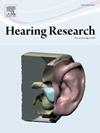Middle-ear sound transmission in human cadaveric temporal bones: fresh vs. fresh-frozen
IF 2.5
2区 医学
Q1 AUDIOLOGY & SPEECH-LANGUAGE PATHOLOGY
引用次数: 0
Abstract
While fresh cadaveric temporal bones are preferable in middle-ear research, limited availability and strict ethical regulation often require the use of fresh-frozen temporal bones as an alternative. Previous studies have shown that freezing and thawing can alter mechanical properties of soft tissues like ligaments, muscles, and joints, yet the effect of freezing on middle-ear sound transmission has not been fully revealed. This study aims to investigate the effects of freezing by comparing the middle-ear transfer function (METF) between fresh and fresh-frozen temporal bones.
Data of 101 human temporal bones (57 fresh and 44 fresh-frozen) were analyzed. The magnitudes of the METF between 125 and 6000 Hz were averaged frequency-wise and compared between both groups. Further, each frequency-response curve was fitted with a rational polynomial, and all fitted curves were averaged for analysis of shape-preserving information such as the location of natural frequencies.
The average METF magnitude was considerably lower for fresh-frozen temporal bones in frequencies below 3000 Hz with differences of up to 7 dB. Shape-preserving analysis of frequency responses revealed two natural frequencies at 900 and 3487 Hz for fresh and at 988 and 3180 Hz for fresh-frozen temporal bones, with no statistically significant differences between fresh-frozen and fresh temporal bones.
With only a slight reduction in METF magnitude at low frequencies compared to large interindividual variabilities, fresh-frozen temporal bones can be considered as an alternative to fresh temporal bones. However, stiffening of middle-ear structures needs to be taken into account when using fresh-frozen temporal bones.
人尸体颞骨中耳声音传输:新鲜vs新鲜冷冻。
虽然新鲜的尸体颞骨在中耳研究中更可取,但有限的可用性和严格的伦理法规往往要求使用新鲜冷冻的颞骨作为替代。先前的研究表明,冷冻和解冻可以改变韧带、肌肉和关节等软组织的力学特性,但冷冻对中耳声音传输的影响尚未完全揭示。本研究旨在通过比较新鲜和新鲜冷冻颞骨的中耳传递函数(METF)来探讨冷冻对颞骨的影响。对101块人颞骨(新鲜颞骨57块,冷冻颞骨44块)数据进行分析。在125和6000hz之间的METF的振幅按频率方向进行平均,并在两组之间进行比较。然后,对每条频率响应曲线进行有理多项式拟合,对拟合曲线进行平均,分析固有频率位置等保形信息。在低于3000 Hz的频率下,新鲜冷冻颞骨的平均METF幅度明显较低,差异可达7 dB。保持形状的频率响应分析显示,新鲜颞骨的固有频率为900和3487 Hz,新鲜冷冻颞骨的固有频率为988和3180 Hz,新鲜冷冻和新鲜颞骨之间无统计学差异。与个体间的大变异相比,在低频率下,METF的幅度只有轻微的减少,因此新鲜冷冻颞骨可以被认为是新鲜颞骨的替代品。然而,在使用新鲜冷冻颞骨时,需要考虑中耳结构的硬化。
本文章由计算机程序翻译,如有差异,请以英文原文为准。
求助全文
约1分钟内获得全文
求助全文
来源期刊

Hearing Research
医学-耳鼻喉科学
CiteScore
5.30
自引率
14.30%
发文量
163
审稿时长
75 days
期刊介绍:
The aim of the journal is to provide a forum for papers concerned with basic peripheral and central auditory mechanisms. Emphasis is on experimental and clinical studies, but theoretical and methodological papers will also be considered. The journal publishes original research papers, review and mini- review articles, rapid communications, method/protocol and perspective articles.
Papers submitted should deal with auditory anatomy, physiology, psychophysics, imaging, modeling and behavioural studies in animals and humans, as well as hearing aids and cochlear implants. Papers dealing with the vestibular system are also considered for publication. Papers on comparative aspects of hearing and on effects of drugs and environmental contaminants on hearing function will also be considered. Clinical papers will be accepted when they contribute to the understanding of normal and pathological hearing functions.
 求助内容:
求助内容: 应助结果提醒方式:
应助结果提醒方式:


